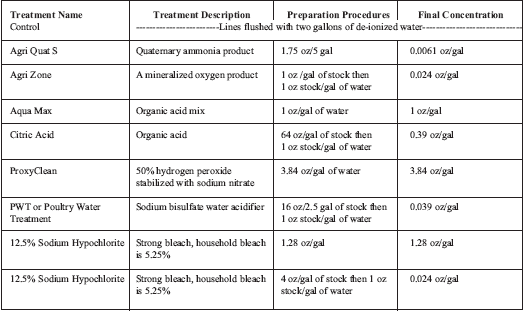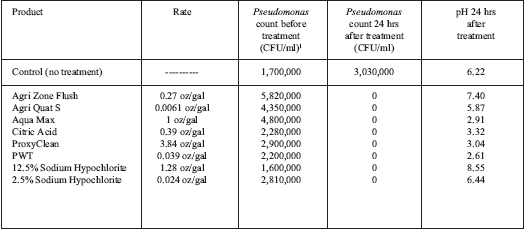



Water Sanitation: Evaluation of Products
By Susan Watkins, Lisa Newberry, Melony Wilson and Robert Hubbard, University of Arkansas - Cleaning water lines between flocks is an important step in providing optimum drinking water for poultry production. Even producers with excellent daily water sanitation programs can still benefit from aggressively cleaning water systems between flocks.| The Author | |
 Dr. Susan Watkins Extension Poultry Specialist |
|
Introduction
Introduction of water additives such as electrolytes, vitamins, or vaccine stabilizers can provide food for unwanted organisms such as E. coli. In addition, the reduction of water flow in drinking systems in order
to provide the right pressure for young chicks and the warm temperatures in poultry houses also
creates a favorable climate for microorganisms to build a biofilm or sticky matrix.
Once
established, a biofilm can be very difficult to remove and if left uncontrolled, this slime can
steadily build up to the point that the daily sanitation program becomes limited in its effectiveness. Even producers who use rural or city water supplies can
still develop microbial problems with poultry house water
systems particularly if they inject products into their water
system via medicators that pull from an open bucket.
It is possible for producers to keep lines clean and
reduce bacterial growth by thoroughly sanitizing the system
between flocks with either sanitizers that are different from
those used in the daily sanitation program or by using the daily
sanitizer at an even higher concentration. However, it is
important to remember that not all cleaners or sanitizers are
designed for use in water lines and equipment is sensitive to
certain types or levels of chemicals. For example, using a
concentrated bleach solution can actually destroy regulators
and nipple drinkers. [Therefore choosing the right cleaner for
water line sanitation is an important step because not only is
the system not very well designed for a thorough cleaning, but
also because of the need to minimize equipment damage.
Once birds are placed in the facility, a producer becomes
limited on the type and concentration of daily sanitizer that the
birds can and will consume. Therefore, by starting birds on
very clean lines, a producer can optimize the effectiveness of
the daily sanitation program and possibly minimize the cost of
the program at the same time.
Cleaner / Sanitizer Study
Different water line cleaners and sanitizers were
evaluated at the University of Arkansas Poultry Research
Farm. A very high level of the bacteria, Pseudomonas, was
seeded into miniature water line systems (four feet long) that
were equipped with six nipple drinkers, a regulator and stem
pipes. By using the miniature lines, it was possible to simulate
conditions that might be encountered on a typical poultry
farm, but at the same time use the different cleaners in three
different water lines. Pseudomonas was chosen because it is
commonly found in poultry houses and because of its ability
to thrive in water systems.
The Pseudomonas mixture was
allowed to settle into the lines for approximately four days so
that the organism would become well established in the water
system, creating a worse case scenario of contamination in a
relatively clean water line system. After four days, a sample of
water was taken from each line to determine the number of
Pseudomonas organisms present. The products tested were
mixed with distilled deionized water, flushed into the line
systems where they remained 24 hours. After 24 hours,
another sample of water from the line was taken and cultured
to determine the number of Pseudomonas organisms that
survived. The treatments evaluated are outlined in Table 11.
Test Results
All products tested effectively removed Pseudomonas
from the water lines (Table 2). Flushing the lines with water
(the control) did not remove the bacteria. However, this was
not a high-pressure flush, which can be very helpful in
removing any buildup in the lines. These results show the
durability of bacteria such as Pseudomonas and why water
lines should be cleaned.
However, using the 12.5% bleach solution at a 1% rate
is risky since strong bleach solutions can have a detrimental
effect on equipment. In fact, it is always best to check with
equipment suppliers for their recommendation of products to
use for line cleaning. The Proxyclean product was used at a
rate of 3%. If products must be added via medicators, this
strength of solution can be achieved only by having an injector
pump with a variable setting or by pumping the solution
straight from the container with two in-line medicators. Most
Proxyclean use has been at a rate of 1% or pumping the
product straight from the container. This adds one ounce of
concentrated product to every gallon of water. The Agri Zone
product can also be used at a more concentrated rate. It can be
pumped straight from the medicator container and added at a
rate of one ounce per gallon of water.
Summary
The bottom line is that water systems can be successfully
cleaned between flocks and this thorough cleaning can
slow or eliminate the development of bio-films. There is one
important point to remember about this project. These lines
were fairly new and therefore had little opportunity for biofilms
and sediment to become built-up in the systems. This
allowed the cleaners to have maximum exposure to the
bacteria and led to excellent results.
Systems that have not
been cleaned in several months or have no daily sanitation
program may not be as easy to clean and may require more
than one clean and flush procedure to eliminate bacteria, algae
and bio-films. If lines are very dirty or a water tests indicate
high levels of bacteria (greater than 100,000 colony forming
units/ml) at the end of the line, then a producer should use a
very aggressive cleaning strategy between flocks. Cleaning
should then be combined with a very thorough flush of the
system to remove the killed bacteria and algae. Dead algae
can release toxins that could be harmful to the birds so it is
very important to flush the system thoroughly after cleaning.
Combining the thorough flush with a good daily sanitation
program can help reduce the threat that bacteria, algae, viruses
and mold exert on poultry performance.

Table 2. Results of Cleaning Water Lines With Different Products

1Colony Forming Units/milliliter

Source: Avian Advice - Spring 2004 - Volume 6, Number 1








